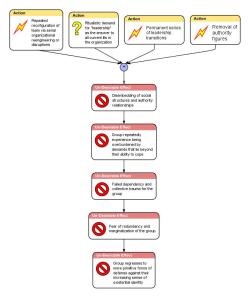Yahoo! Talent Biorhythm Renewal
From a financial standpoint, the size of the challenge facing Yahoo! can be summarized as follows (source: eMarketer):
- Overall revenue at $1.2B was stuck at 2011 level
- Net income fell to $227M
- Yahoo’s share of online-ad revenues has also plummeted, falling from 15.7% in 2009 to 9.5% in 2011.
Given the sheer number of leadership changes and organizational maneouvers that Yahoo! has gone through, restoring “battered employee morale” (Economist, July 2012) needs to be a non-negotiable top priority at the CEO level. That said, embracing this initiative is not going to be an easy journey, given the scrutiny of Wall Street which has greater bias for profits over employee responsibility, and will require sheer persistence (more than an ounce of patience) at the Board of Directors level.
According to a study by Huselich, Becker and Ulrich, a 5% increase in employee commitment leads to a 1.8% increase in customer commitment and a 0.5% increase in financial results.
Anticipating that this is a potential ground floor opportunity to be an Activist Turnaround Manager (ATM), I reflected on this challenge and journaled my perspective. (This is a case study in progress.)
Current Reality Tree of a Conventional Organization
The logic tree below is represents the trauma inflicted in an organizational group that has to evolve through a series of organizational changes.

The building up of the organizational trauma over time results in the following impacts:
- Cumulative group traumatization which systematically destroy the team’s capacity to think and connect.
- Team experiences severe helplessness due to its existential insecurity and permanently overburdened by the tasks that the organization imposes on them.
- The current manager becomes the container or a carrier for the undiscussable taboo scenarios in the organizational culture.
- Realignment of organization headed by survivor leaders and organized into group that displayed the symptoms of transgenerational transference.
- Attachment process in previous group unconsciously interrupted, causing developmental breaks.
- Old group is sidelined, symbolically assassinated or retired.
- Insecure attachment between leader and group and preference of group to become compliant and a malleable band of followers.
- Traumatized psychological processes, generally denied and made socially unconscious, take hold of the group and surface during the next transition or crisis.
- Survivor group unconsciously views itself as the only reliable guardians of continuity and develop symptoms of survivor guilt.
- Incomplete group mourning processes cause unexpressed shame and guilt and the fear of annihilitory persecution and fragmentation.
- Real guilt of perpetrator (leader) is turned into guilt feelings of victim.
- High level of mutual distrust between group and survivor leader.
- Psychological holding structures of organization are deconstructed.
Future Reality Tree of Yahoo!’s Culture

Recommendation: Establish a theatre for Yahoo talent to develop and discover their biorhythms using the power of social therapeutics.
Rationale: Talent management is the growth engine for fostering innovation.
References
Brian E. Becker, Mark A. Huselid and David Ulrich, The HR Scorecard: Linking People, Strategy, and Performance, Harvard Business Press, 2001.
Earl Hopper (ed.), Trauma and Organizations, Karnac Books Ltd, 2012.
Blogged by Last Mile Resource
Posted on July 29, 2012, in Uncategorized. Bookmark the permalink. Leave a comment.
Leave a comment
Comments 0